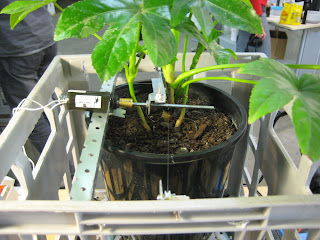ok, so it's important for this medialab project to find its focus and work toward an outcome.
one of the overarching limitations i have, working with plants, and especially working with the behaviours of plants, is that they have such a long-cycle of action. they take hours and hours, if not days and days, to elicit any real discernible actions.
this is totally cool in the grand scheme of things. and even in the very limited time frame of a traditional art exhibition - 3 to 6 weeks, this is also fine. in that scenario i can envisage a project going for that long, that also has a documented record of the show as it goes, which would enable the viewer to see perhaps something like a timelapse history of the plant behaviours. or, the other thing that interests me, is for the occasional plant activities to then set in motion other activities beyond themselves (for example, to have them make trades on the stock exchange).
for this project it's important to produce an outcome at the end and i would like to have a completed work that demonstrates the 'networked behaviours of technologically augmented plant bodies'.
the key is to decide what TRIGGER sets the plants in motion, literally. i have been working toward providing the plants with an ability to move (SHIVER and WAVE) but am yet to decide what it is that makes them do it. the easy answer is to have the proximity of humans do it. but that's been done a lot and isn't really pushing any new ground. for me, i'm most interested to have the plants operate so that they respond to each other. but here again we run up against the problem of their limited action range, and the context of this project being a very short time frame.
in wondering about how to shed some light on the project, and after talking to jesse today, i looked up 'environmental triggers for plants' and it was obvious the importance of light.
let there be light!
this enables the plants to react to fairly common environmental conditions, as varying light levels are easily achieved and often only ever restricted for the benefit of an art display. which means in this case, light levels will be encouraged to be more naturally fluctuating.
additionally it offers the chance for humans, should they wish to prod the plants into action, to shine something on a plant and also participate in affecting the network. they aren't being the sole effector, but they can be a component.
the natural light of the sun is the natural source of energy for the plants, why not let it be the natural source of energy for their newly augmented mobility? and humans, with their clever ways of harnessing energy and producing their own lights, can also participate.
what would be nice too, would be for that to be the trigger of the movement in the plants, and then to allow that movement to then dictate the pattern of behaviour that washes through the network afterwards, such that the network internally coordinates itself as a consequence.


















































